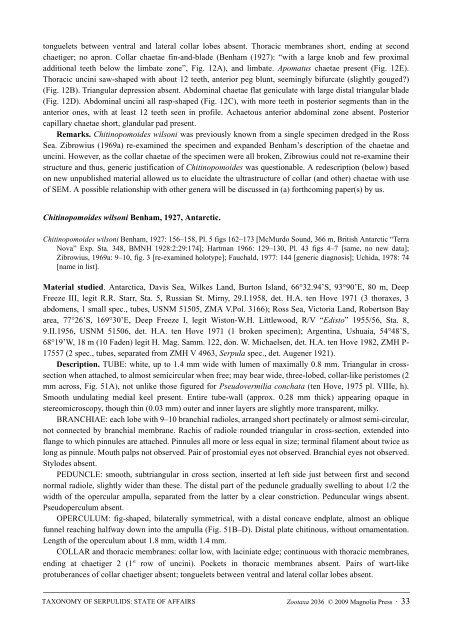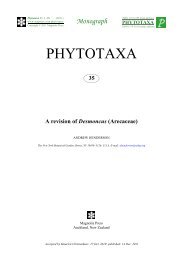Zootaxa, Taxonomy of Serpulidae (Annelida ... - Magnolia Press
Zootaxa, Taxonomy of Serpulidae (Annelida ... - Magnolia Press
Zootaxa, Taxonomy of Serpulidae (Annelida ... - Magnolia Press
You also want an ePaper? Increase the reach of your titles
YUMPU automatically turns print PDFs into web optimized ePapers that Google loves.
tonguelets between ventral and lateral collar lobes absent. Thoracic membranes short, ending at second<br />
chaetiger; no apron. Collar chaetae fin-and-blade (Benham (1927): “with a large knob and few proximal<br />
additional teeth below the limbate zone”, Fig. 12A), and limbate. Apomatus chaetae present (Fig. 12E).<br />
Thoracic uncini saw-shaped with about 12 teeth, anterior peg blunt, seemingly bifurcate (slightly gouged?)<br />
(Fig. 12B). Triangular depression absent. Abdominal chaetae flat geniculate with large distal triangular blade<br />
(Fig. 12D). Abdominal uncini all rasp-shaped (Fig. 12C), with more teeth in posterior segments than in the<br />
anterior ones, with at least 12 teeth seen in pr<strong>of</strong>ile. Achaetous anterior abdominal zone absent. Posterior<br />
capillary chaetae short, glandular pad present.<br />
Remarks. Chitinopomoides wilsoni was previously known from a single specimen dredged in the Ross<br />
Sea. Zibrowius (1969a) re-examined the specimen and expanded Benham’s description <strong>of</strong> the chaetae and<br />
uncini. However, as the collar chaetae <strong>of</strong> the specimen were all broken, Zibrowius could not re-examine their<br />
structure and thus, generic justification <strong>of</strong> Chitinopomoides was questionable. A redescription (below) based<br />
on new unpublished material allowed us to elucidate the ultrastructure <strong>of</strong> collar (and other) chaetae with use<br />
<strong>of</strong> SEM. A possible relationship with other genera will be discussed in (a) forthcoming paper(s) by us.<br />
Chitinopomoides wilsoni Benham, 1927, Antarctic.<br />
Chitinopomoides wilsoni Benham, 1927: 156–158, Pl. 5 figs 162–173 [McMurdo Sound, 366 m, British Antarctic “Terra<br />
Nova” Exp. Sta. 348, BMNH 1928:2:29:174]; Hartman 1966: 129–130, Pl. 43 figs 4–7 [same, no new data];<br />
Zibrowius, 1969a: 9–10, fig. 3 [re-examined holotype]; Fauchald, 1977: 144 [generic diagnosis]; Uchida, 1978: 74<br />
[name in list].<br />
Material studied. Antarctica, Davis Sea, Wilkes Land, Burton Island, 66°32.94’S, 93°90’E, 80 m, Deep<br />
Freeze III, legit R.R. Starr, Sta. 5, Russian St. Mirny, 29.I.1958, det. H.A. ten Hove 1971 (3 thoraxes, 3<br />
abdomens, 1 small spec., tubes, USNM 51505, ZMA V.Pol. 3166); Ross Sea, Victoria Land, Robertson Bay<br />
area, 77°26’S, 169°30’E, Deep Freeze I, legit Wiston-W.H. Littlewood, R/V “Edisto” 1955/56, Sta. 8,<br />
9.II.1956, USNM 51506, det. H.A. ten Hove 1971 (1 broken specimen); Argentina, Ushuaia, 54°48’S,<br />
68°19’W, 18 m (10 Faden) legit H. Mag. Samm. 122, don. W. Michaelsen, det. H.A. ten Hove 1982, ZMH P-<br />
17557 (2 spec., tubes, separated from ZMH V 4963, Serpula spec., det. Augener 1921).<br />
Description. TUBE: white, up to 1.4 mm wide with lumen <strong>of</strong> maximally 0.8 mm. Triangular in crosssection<br />
when attached, to almost semicircular when free; may bear wide, three-lobed, collar-like peristomes (2<br />
mm across, Fig. 51A), not unlike those figured for Pseudovermilia conchata (ten Hove, 1975 pl. VIIIe, h).<br />
Smooth undulating medial keel present. Entire tube-wall (approx. 0.28 mm thick) appearing opaque in<br />
stereomicroscopy, though thin (0.03 mm) outer and inner layers are slightly more transparent, milky.<br />
BRANCHIAE: each lobe with 9–10 branchial radioles, arranged short pectinately or almost semi-circular,<br />
not connected by branchial membrane. Rachis <strong>of</strong> radiole rounded triangular in cross-section, extended into<br />
flange to which pinnules are attached. Pinnules all more or less equal in size; terminal filament about twice as<br />
long as pinnule. Mouth palps not observed. Pair <strong>of</strong> prostomial eyes not observed. Branchial eyes not observed.<br />
Stylodes absent.<br />
PEDUNCLE: smooth, subtriangular in cross section, inserted at left side just between first and second<br />
normal radiole, slightly wider than these. The distal part <strong>of</strong> the peduncle gradually swelling to about 1/2 the<br />
width <strong>of</strong> the opercular ampulla, separated from the latter by a clear constriction. Peduncular wings absent.<br />
Pseudoperculum absent.<br />
OPERCULUM: fig-shaped, bilaterally symmetrical, with a distal concave endplate, almost an oblique<br />
funnel reaching halfway down into the ampulla (Fig. 51B–D). Distal plate chitinous, without ornamentation.<br />
Length <strong>of</strong> the operculum about 1.8 mm, width 1.4 mm.<br />
COLLAR and thoracic membranes: collar low, with laciniate edge; continuous with thoracic membranes,<br />
ending at chaetiger 2 (1 st row <strong>of</strong> uncini). Pockets in thoracic membranes absent. Pairs <strong>of</strong> wart-like<br />
protuberances <strong>of</strong> collar chaetiger absent; tonguelets between ventral and lateral collar lobes absent.<br />
TAXONOMY OF SERPULIDS: STATE OF AFFAIRS<br />
<strong>Zootaxa</strong> 2036 © 2009 <strong>Magnolia</strong> <strong>Press</strong> · 33
















